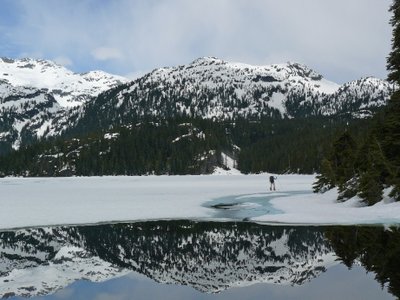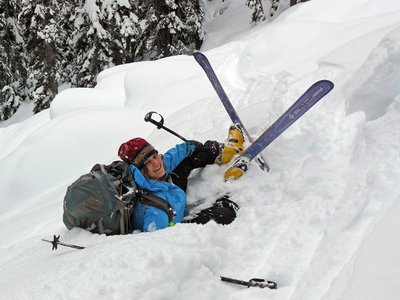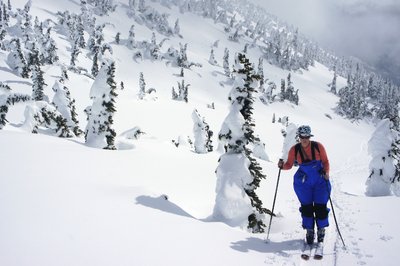
Ring-Callaghan Traverse: Clawing the Thin Ice

I love frozen lakes. The thin ice covering them is like a call to arms. I feel drawn to the ice, to test it, walk on it, throw sticks and rocks at it, and am always surprised to see them bounce off the ice instead of making a splash in the water. Maybe this has something to do with growing up in the Middle East, where ice exists strictly in the freezer. My wonder at ice formations extends of course to the biggest pieces of ice we are likely to bump into, glaciers. Getting close to glaciers and traveling across them is still a novelty to me. This trip took us across a spectacular glacier, which was our home for one night, and back down the other side.
Piotr Forysinski had planned this “intermediate friendly” trip, a two day traverse from the Callaghan cross-country area to the Squamish Valley near Ring Mountain. I drove up to Callaghan (with Christian and Line Veenstra, Doris Leong and Roland Burton), and Piotr drove up the other side, and we planned to swap cars. Jordan Best’s group also joined us, driving in and out the same way. We all met up in Squamish, but had to wait for one person, an experienced mountaineer, who didn’t wake up in time. After switching keys and wishing each other good luck, we set off in our separate directions.
When we turned on to the road to Callaghan I mentioned that I had seen a few bears on that road a few weeks before. Sure enough, a few minutes later we came across a bear on the side of the road, and a group of people who were busy taking photos with a huge lens from across the road, while we stopped right beside the bear, who was oblivious to all this. Later we passed another bear and cub, and one more bear. Perhaps carrying bear spray would have been a good idea. We managed to drive directly to snowline with no trouble.
We skied along a mostly flat logging road for about 6km making good time to Callaghan Lake. Just before reaching the lake, we debated two options: a route Christian and Line had followed once in the past, up a tree covered ridge to our left (NW), or going around the right (NE) side of the lake and gaining a ridge with many lakes. The forest on the right looked nice and open, and Christian was curious to see the other route so we chose the latter. Soon we arrived to the shore of the lake, which had visible water almost all around the edges, but was snow covered for the most part. Christian was convinced that crossing the lake was safe enough and, by moving along and probing the ice every step, he managed to proceed for a few minutes before getting his foot soaked, and turning back.

A few minutes later Christian went back out onto the lake, and this time managed to stay on top, disappearing into the distance within a few minutes. This was a very surreal scene, with Christian literally “walking on water” – the layer of snow or ice must have been very thin. We followed the shore of the lake and shouted for Christian a few times, but he was too far away. If he had fallen in, he would have had serious difficulty getting back out by himself. Finally we reached the steep side of a gully and were forced to go up, away from the lake. Here we managed to communicate with Christian, and finally regrouped and had lunch. This whole episode reminded me of the Pink Floyd song “The Thin Ice”

“If you should go skating
On the thin ice of modern life
Dragging behind you the silent reproach
Of a million tear-stained eyes
Don’t be surprised when a crack in the ice
Appears under your feet.
You slip out of your depth and out of your mind
With your fear flowing out behind you
As you claw the thin ice.”

We headed up a wide and open gully, until we reached a small col on the ridge. From there we followed below the ridge passing by a few small snow covered lakes, and then gained the ridge. Christian ran down to get us all water from one of the lakes, and we continued. Our objective was to get on to a large glacier leading up to Mt. Callaghan. We had to ski a short section below some steep slopes where it would have been foolhardy to linger. After that we were on a wide almost flat glacier, and the going got much easier but the terrain changed a lot less. The glacier seemed to create a distorted view of the terrain – everything seemed closer and steeper than it actually was. We were approaching a steep part of the glacier, where the Veenstras had turned around on their previous attempt due to a huge avalanche. This time it seemed we would manage to get up, but we had to take our skis off to boot pack up the last steep part.
At the top, where the glacier met the rock, there was a snow cliff, which formed a stadium-like shape, very interesting, but quite impassable. Going around it was easy though, and once again we were on a huge almost flat glacier, like a sea of snow. Slog, slog, slog…

Here Christian got out his kite to practice some kite skiing, which is somewhat similar to kite surfing, but you skate ski along while the wind pulls you. He made some good progress, while we stayed a bit higher. The sun was already low since it was late in the evening, so we had very long shadows and it occurred to me that by the shadows we could be mistaken for UFOS. We were heading in what I thought was the correct direction, but still couldn’t see the other group. Eventually we managed to contact them by radio, and by that time we were just a few minutes away. They had also had a long day, although for them it consisted of much more driving, and some bushwhacking up an old logging road, which awaited us the next day.

It was 9:30pm and the sun was setting on a beautiful bluebird day. We set up our tent, built some snow walls for wind protection, a latrine and a kitchen, had dinner and chatted about our day. The wind picked up and we huddled together to stay warm. After sleeping only 3 hours the previous night I was looking forward to a good night’s sleep, but the night kept on getting shorter. By the time the last of us got to bed it was already almost 1am. The next day we headed to Mt. Callaghan, which involved going up a short annoying icy section.

Mt. Callaghan is a large glaciated massif, but the peak itself is quite small and inconsequential. We took some group photos on the summit and identified some of the many peaks. Len Goff was convinced he could see people on the summit of Mt. Cayley, but it turned out they were just huge boulders. We headed back along the ridge and up on to a small rocky summit behind camp. This demanded a few scrambling moves on rock covered with snow, on to a tiny summit composed of a rickety pile of rocks.

Back at camp we packed up quickly and headed towards Ring Mtn. The skiing was fabulous down the glacier, and soon enough we were traversing the flanks of Ring Mtn. The snow was getting mushy, and Line and Christian thought the traverse was dangerous. Instead, Christian and I scrambled and boot packed up a steep gully, which took us to the summit crater. We headed down quickly, and ended up skiing across an avalanche path that held very heavy and moist snow. It was probably wise that we had hastened our steps, since it was getting mushy enough to produce a slide. We continued skiing down, and met up with the rest of the group.
Ring Mountain is a tuya, a rare type of volcano. Geologists tell us that it erupted from underneath a thick sheet of glacial ice. The heat of the lava melted the ice and it punched through the top of the ice sheet, creating the distinctive flat top. The steep slopes of rotten rock right around the mountain were supported by ice at that stage, which subsequently receded. Most probably no humans were around at that time, but it must have been a spectacular show!

A bit farther down I came upon Doris lying on the ground and Roland beside her. She had fallen and twisted her knee badly. We gave her some Ibuprofen and had a rest. We debated what to do: would she be able to ski or hike out, or would we have to call for a rescue. After a few painful trial steps it became apparent that she would be able to hike out, so we divided up Doris’ gear amongst us. Christian took her pack, which he strapped behind his own pack, creating a monster-sized pack. I ended up with “two of everything” as Roland put it, two pairs of skis, two shovels, probes, and ice axes. We continued, now moving a bit slower. The trees gradually became denser until we emerged out to a steep clear cut and the snow covered logging road.

After a few kilometers we had to strap our skis on our packs and started hiking down. The road became overgrown with alder, but muscling our way through was still possible. I used my poles for face protection. A few sections were dense, but we made it through and were happy to find Piotr’s jeep in good shape. Apparently Jordan had driven 200m further than Piotr, breaking a headlight and a side mirror. The drive down was interesting, through a tunnel of alder and two washouts that seemed impassable to us, the 2wd “normal car” drivers.
We arrived to the Shady Tree pub in Squamish where we ordered a tasty dinner and waited for the second crew. They arrived about an hour later, after trying to descend the ridge route but being stopped by a whiteout, and then following our tracks for most of the way down. They went around the West side of the lake, which was a much more straightforward route, but they ended up having to ford the freezing cold hip deep outlet of the lake, unaware that there is a bridge just a two minute hike away… After sharing a second dinner with the other group, we hobbled back into the cars and drove back to Vancouver, sadly leaving the land of snow and ice until the next trip.
Notes:
1. This article also appeared in VOCJ 53, pages 89-94.
2. When Callaghan Lake is completely frozen, skiing across it would be much easier than following the shore line. When it is not frozen, probably it is better to follow the W shoreline (and not E, as we did) since it is much flatter. To do this you must cross the outflow of Callaghan Lake, but luckily there is a bridge.


